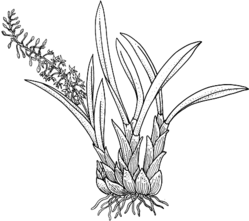
Description: Epiphytic [or epilithic or terrestrial] herbs, sympodial or monopodial; roots mostly creeping over the surface of the substrate [or subterranean], somewhat fleshy. Stems differentiated into rhizome and pseudobulb or undifferentiated; pseudobulb of several to many internodes.
Leaves scattered along the pseudobulb or stem, 1 to several per shoot, distichous, conduplicate [sometimes petiolate, or rarely leaves absent].
Inflorescence racemose, mostly many-flowered, lateral; flowers resupinate. Dorsal sepal free, similar to lateral sepals. Lateral sepals free. Lateral petals free, about as long as, or slightly shorter than dorsal sepal. Labellum free, attached at base of column [or to a short column foot]; lamina 3-lobed, bearing 2 [or 1] longitudinal keels [or calli] or a shallow, viscid depression. Column lacking free filament and style; column wings fused to column, expansive in upper half, narrow [to broad]. Column foot absent [or vestigial]. Anther incumbent, cap-like. Pollinia 2 [or 4], waxy. Stigma entire. Rostellum not prominent, ventral.
Distribution and occurrence: World: 44 species, tropical and subtropical Asia through Malesia to Australia. Australia: 3 species (endemic), Qld, N.S.W., W.A., N.T.
Text by P. H. Weston
Taxon concept:
| | Key to the species | |
| 1 | Leaves succulent, rigid, deeply V-shaped in cross section; labellum lamina with 2 parallel keels | Cymbidium canaliculatum |
| Leaves leathery, flexible, slightly V-shaped in cross section; labellum lamina with one indistinct keel or without distinct keels | 2 |
| 2 | Leafy part of stem a compressed-ovoid to narrow-ovoid pseudobulb; growth sympodial | Cymbidium madidum |
| Leafy part of stem cylindrical; growth limited, monopodial
Back to 1 | Cymbidium suave |
|


